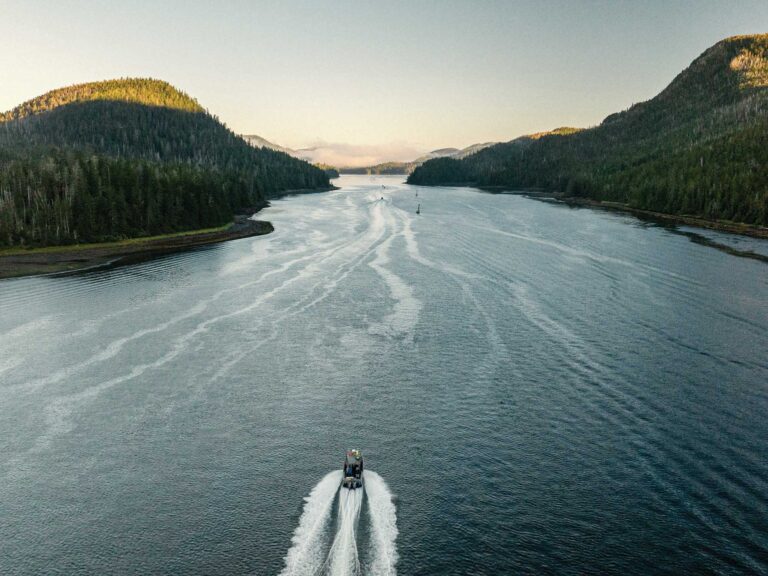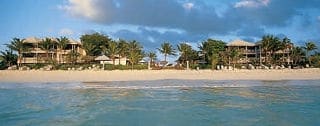
| The Ocean Club’s numerous amenities include two pools and meticulously groomed tropical landscaping. |
If you’re a bonefish enthusiast who likes to keep up on the latest hot spots, you’ve no doubt heard a good bit about the Turks and Caicos lately. Actually, so has a lot more of the general public, as the Turks and Caicos – a British Crown Colony located just south of the Bahamas – recently ramped up efforts to promote the islands as a world-class tourist destination. If you decide to check it out, you’ll find a group of low-lying, limestone-based islands with fantastic beaches, a laid-back atmosphere and spectacular coral reefs. And when you return, you will be asked two questions: (1) What’s the fishing like? (2) What’s with the weird name?
Those two questions were foremost on my mind last May when my wife, Elizabeth, and I flew to Providenciales, the capital of the T&C;, as well as the most developed of the islands. A mural in the international airport suggested that the “Turk” in question was some sort of squat cactus with a red, fez-like top, while a “Caico” appeared to be – what’s this? – a spiny lobster? Digging deeper, we confirmed the first part of the equation (the barrel, or Turk’s Head, cactus thrives in the T&C;’s arid environment), but met with conflicting opinions where the second was concerned. We asked cab drivers and desk clerks, hotel maids and waiters, but no one seemed to know for sure. One person claimed a “caico” was a species of lizard, while others said it was the name of ancient Indians that once inhabited the islands. Perhaps it meant bonefish, I wondered hopefully.
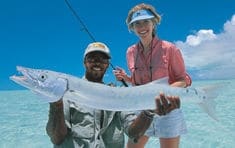
Provo guide Arthur Dean and Elizabeth Richardson pose with a barracuda that fell for curl-tail grub rigged on a leadhead jig.|
We received a more definitive answer to the fishing question via the folks at Silver Deep Charters, run by the high-energy Arthur Dean and his Italian-born wife, Paola. A native of Provo (as Providenciales is called by those who live there), Arthur caught the fishing and diving bug as a young boy growing up in the west-end community of Blue Hills. He started guiding in his late teens, and later established Silver Deep, which he and Paola have built into the largest guided fishing and diving service in the T&C.; Although he and Paola also run reef-fishing, offshore fishing, diving, snorkeling and sight-seeing excursions, Arthur’s real passion is bonefishing. The fact that he and Paola tied the knot on a favorite flat should offer some proof of that, but seeing him in action is the clincher.
Big Bones No Bull
On our first morning in Provo, we were picked up at our hotel by a Silver Deep van and shuttled to the Leeward Marina on the east end of the island. The place was hopping with divers, fishermen and other water-sports enthusiasts preparing for a day on and in Provo’s crystalline waters. The sun was shining and the wind was light. As we stood on the wharf, appreciating the cloudless sky and light wind, a smiling Arthur Dean (clad in olive fishing garb and sporting his signature collection of silver necklaces) appeared from amid the confusion and ushered us aboard his 17-foot Action Craft, Grabbit. After idling out of the marina with a passing nod to Jo-Jo, the local dolphin celebrity, Dean jammed the throttle forward and we rocketed off at 60 mph, bound for a series of remote creek flats along the southwestern shore of neighboring North Caicos Island.
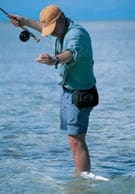
There are plenty of places to wade-fish for bones in the waters surrounding Provo. The author plucked this fish from a big school that was moving across a shallow grass flat on a dropping tide.|
Thirty minutes later we arrived at our first stop, a marl-bottomed area surrounded by low mangroves that Dean calls Deaf Creek, named after a hearing-impaired client of his. The tide was rising, and Dean knew that bonefish would be moving along the mangrove shoreline, rooting for crabs and shrimp. The mottled bottom of the creek made it a bit challenging to spot fish, but Arthur soon alerted me to a long shadow that was moving right to left, just 30 feet away. I fired off a cast, but the fly landed behind the fish and sent it zig-zagging for deeper water, trailing a wake of marl.
No matter. We soon saw more fish, all of them big singles of at least five pounds. Since the water was two to three feet deep, Dean recommended that I try a fast-sinking spawning-shrimp pattern with lead eyes. It turned out to be the right move, as the fly was immediately hoovered by the very next fish that happened along. We estimated its weight at around eight pounds, and was one of the biggest bones I had ever taken on a fly.
I was beginning to see that the T&C;’s reputation for producing bragging-sized bonefish wasn’t just hype. According to Dean, the average bone in many of the spots he fishes runs eight pounds, and the biggest ever landed on his boat was a 14 1/2-pounder. He even claims to have seen a fish in the18-pound range. What’s more, many of the remote areas he fishes don’t see a lot of pressure, as they are largely beyond the range of other local guides.
Variety of Flats
After releasing my fish, it was Elizabeth’s turn on the casting deck. By now the water was high enough for the fish to hide among the mangroves, but two casts later Elizabeth had her fish – a crafty little three-pounder whose attempts to escape by wrapping the line around a mangrove shoot were foiled by Dean’s quick thinking and considerable poling skills. We released that fish, then stashed our gear and headed for another nearby flat.
| ## Staying in Provo:### The Ocean Club |
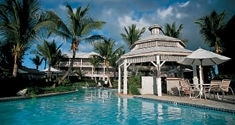
The Ocean Club’s numerous amenities include two pools and meticulously groomed tropical landscaping.|
The Ocean Club served as our comfortable base of operations during our week-long stay in Provo. This is an exceptionally well-managed resort, and features immaculate, well-groomed grounds and a friendly staff. The club has two pools, a health spa, a small store, tennis courts, Internet access and a video library. It is located on Grace Bay, on the north side of the island, which boasts a gorgeous white-sand beach bordering turquoise waters. A small water-sports operation is located next to the Club where you can rent kayaks, small outboard skiffs and Hobie-Cat sailboats.
There are a variety of rooms at the Ocean Club, from studios to three-bedroom suites. Many are condos, which are available for sale. Our air-conditioned, one-bedroom suite had two bathrooms, a dining table, a screened deck with ocean views, and brand-new appliances, including a dishwasher, full-sized refrigerator, four-burner stove and an oven. It also came with a full complement of plates, pots, utensils and everything else you need to prepare your own meals. If you like grilling, communal gas grills are located by the pools.
Feel like dining out? There are plenty of options. If you want to stay close to home, there’s a good restaurant called The Gecko located at the Ocean Club, as well as a great pool- and beachside snackbar/grill where you can get drinks, burgers, hot dogs, fries, conch fritters and all kinds of tasty beach fare during the day. In addition, there are numerous restaurants and bars on Provo, and the Ocean Club even provides inexpensive shuttle service to some of them. A few beachside restaurants are also located within walking distance of the club.
For more information on the Ocean Club Resorts, call (800) 457-8787 or visit www.oceanclubresorts.com. You can also contact their reservation office at e-mail address res@oceanclubresorts.com.
– Tom Richardson
This was an open expanse of shallows with a white marl bottom. After a quick look around from the poling platform, Dean spotted a big school of bonefish that was stirring up a large mud in the middle of the flat. Cruising the outskirts of the cloudy water was a pair of large barracuda, one of which we hooked on a light spinning outfit rigged with a grub-tailed jig. ‘Cuda always provide an exciting break from the bonefishing routine, at least in my book, and this 15-pounder was no exception. I’m sure the bonefish enjoyed it too.
After pulling a couple of bones from the big flat on flies and small jigs, we paused for lunch and then set a course for some ultra-shallow flats where Dean said we could wade for tailing fish. Almost as soon as we stepped out of the skiff we saw the tails of bonefish wriggling across the grassy bottom. Elizabeth and Dean waded in one direction while I struck off in another, and we all encountered lots of fish. Then, as the tide continued to drop, exposing more of the grass-covered bank, multiple schools of bonefish began vacating the flat, one right after another. It was like standing on the edge of a bonefish highway. Dean had us stand in one spot and cast to the schools as they swam past. Each school contained 100 or so fish, but these bones were surprisingly hard to fool, probably because they had largely finished eating and were intent on reaching the security of deeper water as the tide dropped. However, we did manage to pluck a few fish from the passing schools before the flat was completely emptied and it was time to head back to the dock.
But the trip wasn’t over yet. As we approached the marina, Dean shut down and began to pole us over a narrow grass flat on the edge of the busy channel. Incredibly, this well-traveled area held the biggest bones we had seen all day. We saw several fish in the double-digit range, but they proved too clever for us. However, it served to drive home the point that Provo is home to some behemoth bonefish.
Reef and Offshore Options
Of course, there’s more to fish for in the Turks and Caicos besides bonefish. Later in the week, Elizabeth and I joined guide Godfrey Smith for a half-day bottom-fishing trip aboard Silver Deep’s 27-foot Angler center console.
A 15-minute run from the marina put us over a reef drop-off in some 120 feet of water off Parrot Cay. After dropping anchor, we baited up with small chunks of squid and parrotfish and lowered our rigs to the bottom. In short order we were hauling in an assortment of reef species that included strawberry grouper, parrotfish, yellowtail snapper, triggerfish, dog snapper, sharks and that most dreaded of bait-stealers, the black durgeon. Most of the fish were on the small side, but they provided us with some nice fillets for a few meals. Better action with bigger fish is available, too, but this generally involves a longer run, which necessitates a full-day trip. According to Smith, the best time for big grouper – Warsaw, Nassau, black, strawberry and yellowfin – is November through February. Night reef-fishing trips can also be arranged through Silver Deep.
| ## Planning a Silver Deep Adventure | ||
| Silver Deep offers a wide variety of fishing options, ranging from flats fishing to offshore trolling. In addition, they also run dive and snorkel trips for advanced and beginner alike. Picnic and sightseeing cruises are available, too, and in some cases the boats can pick up and drop off right at your hotel’s beach or dock. Incidentally, Silver Deep can arrange custom trips, including tropical weddings in unusual romantic spots. To contact Silver Deep, call (649) 946-5612; fax (649) 946-4527; e-mail: silverdeep_dean@tciway.tc; or visit their website at www.silverdeep.com. |
Silver Deep also offers offshore trips for wahoo, tuna, marlin and dolphin in season. The wahoo fishing off Provo is excellent during the winter, as long as conditions allow boats to get out to the reef drop-off. Yellowfin tuna action is best from April through July, with the fish running up to 100 pounds or so. Dolphin and marlin are available from late spring through summer, and the islands host a marlin tournament in July. During last year’s Caicos Classic Release Tournament, 34 marlin were caught during the four-day event by a field of 13 boats. More and more big-game anglers are bringing their boats over from the U.S. to sample these waters, and Provo has several marinas along its north shore that offer excellent services and quick access to the most productive offshore grounds. Lines go in the water just beyond the reef, which lies just a few miles from shore.
Although we never sampled the blue-water action during our week-long stay on Provo, we can definitely vouch for the bonefishing. The fish are large, numerous and aren’t heavily fished for the most part. They certainly lived up to their reputation. In fact, about the only letdown to the trip was finally discovering the meaning of the word “caicos.” According to the tourist board website, “caicos” simply means “little islands” or “cayes.” Not too romantic, so if anyone asks, I’ll tell ’em caicos are bonefish – at least in my book.





